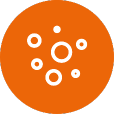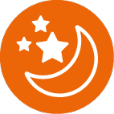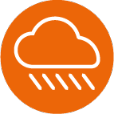SIGNS & SYMPTOMS
There are several hallmark signs and symptoms associated with PN. Below, we’ll look at what they are and how they can present.

Itch
Individuals with PN often experience periods of intense itching, which can vary in duration.1 In fact, individuals living with PN may experience itch at the highest severity compared with other chronic itch conditions.2 The itch may be accompanied by pain, burning, stinging sensations and bleeding.3

Bumps (nodules and other raised lesions)
Persistent scratching results in the formation of itchy bumps on the skin.1 These nodules (hard, raised bumps) can range in size from a few millimetres to over three centimetres in diameter.1,4 They can appear anywhere on the skin, but commonly affect the arms, legs, back and abdomen, presenting symmetrically on both sides of the body.1
These nodules may start off as small, intensely itchy bumps on the skin, but they become larger and more domeshaped when continuously scratched over time.5 Depending on the color of your skin tone, the bumps can manifest in diverse hues ranging from the color of your skin to pink, red or brownish black.1 An individual can have a few bumps or more than 100 on the skin.1 When these bumps clear, they may leave behind spots that are either darker (hyperpigmentation) or lighter than your natural complexion.1
The impact of PN goes beyond the skin1,6,7

Lifestyle impact
The symptoms of PN significantly affect an individual’s quality of life. The intense itch can be disruptive to daily life, affecting performance at school or work, and the often highly visible bumps may deter participation in social activities.1,8

Sleep Quality
Getting quality sleep with PN is challenging, especially since the itch intensifies in the evening. More than 60% of people living with PN report that their itch severely disrupts their sleep.7 The lack of sleep can leave you feeling tired and sleepy during the day, negatively affecting productivity.9,10

Mental health
Given the profound impact of PN on one’s quality of life, it’s unsurprising that the condition also affects an individual’s mental well-being. Patients with PN often report feelings of sadness, shame and helplessness because of their condition. Moreover, PN is also associated with higher rates of mental health issues, including depression and anxiety.1,6,8
Reference:
- American Academy of Dermatology Association. Prurigo nodularis: Signs and symptoms. Available at: https://www.aad.org/public/diseases/a-z/prurigo-nodularis-symptoms. Accessed August 2023.
- Aggarwal P, et al. Clin Exp Dermatol 2021;46(7):1277–1284.
- National Organization for Rare Diseases. Prurigo Nodularis. Available at: https://rarediseases.org/rare-diseases/prurigo-nodularis/. Accessed August 2023.
- Yale Medicine. Prurigo Nodularis. Available at: https://www.yalemedicine.org/conditions/prurigo-nodularis-overview. Accessed August 2023.
- DermNet NZ. Nodular prurigo. Available at: https://dermnetnz.org/topics/nodularprurigo. Accessed: August 2023.
- Huang AH et al. J Invest Dermatol 2020;140(2): 480–483.e4.
- Gwillim E et al. Acta Derm Venereol 2021;101(3): adv00424.
- Pereira M et al. J Eur Acad Dermatol Venereol 2018; 32(7):1059–1065.
- Podder I, et al. Int J Womens Dermatol 2021;7(4):403–410.
- Garcovich S, et al. Vaccines (Basel) 2021;9(3):303.
The health information contained herein is provided for general educational purposes only. Your healthcare professional is the single best source of information regarding your health. Please consult your healthcare professional if you have any questions about your health or treatment.